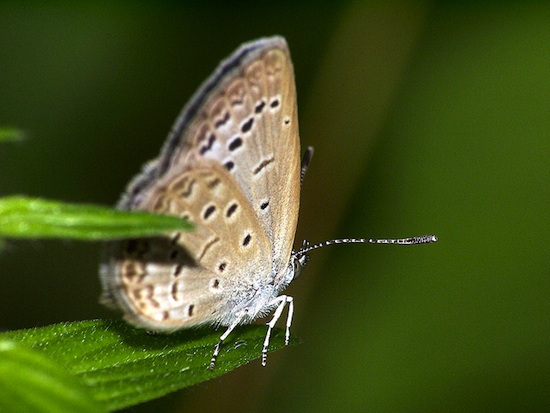Today’s reminder that nuclear accidents stay with us much, much longer than we might care to remember them: Butterflies in the vicinity of the disaster at the Fukushima nuclear reactor in Japan are mutating. A study published online last week in the journal Science Reports found that pale blue grass butterflies are common in much of Asia, but those born near the site of the meltdown are coming into the world with severe physical deformities. Mutations have been found in 12% of the specimens examined by researchers at the University of the Ryukyus in nearby Okinawa. While some of the mutations, like unusual spotting patterns on wings, are mostly innocuous, others are more severe, ranging from forked antennae, to twisted legs, to bent and useless wings. Some are suffering from mutations that leave them unable to even leave their cocoons.
While this doesn’t close the book on the dangers of low-dose radiation, there’s no good news to be found here, and plenty of bad. The severity of the animals’ mutations correlates with their proximity to radiation hotspots. These hotspots remain common in the area around the infamous Fukushima Daiichi reactor that suffered a critical failure in March of last year.
Even worse news? These butterflies were captured six months after the release of radiation into the surrounding area, and suffered from twice as many abnormalities and mutations as butterflies caught by the same team of researchers just two months after the meltdown. That suggests that while the levels of radiation in the area are still dropping, the effects of that radiation are getting more severe as butterflies consume plants that have been tainted with radiation.
It also points to a troubling possibility — that the butterflies may be passing genetic defects on to subsequent generations. That inheritance of genetic damage is one of the major potential dangers of low-dose radiation, and while the jury is still out on whether that’s exactly what’s happening here, it doesn’t paint a rosy picture for anyone or anything living near the site. Only time will tell, but there’s no reason to think this is the end of the story on the long term repercussions of the Fukushima disaster. And it won’t just be butterflies that are affected.
Anybody need a drink yet? Yeah, us too.
(via LiveScience)
- Butterfly swarm attacks man in astounding, probably fake video
- A scientist created a super deadly version of the bird flu last year. Did you know that?
- Angry Birds is the product of mutated muppets









Published: Aug 14, 2012 07:40 pm